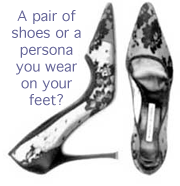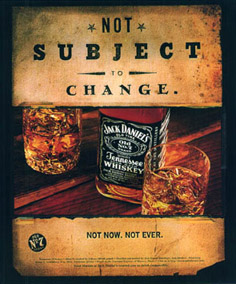
What Is A Brand?
 In
an age where products are bought, rather than sold (think about it...)
buyers make their choices according to brand identity, relying on the endorsement
of a product that is provided by the brand name. A brand offers a form
of guarantee, a set of ready made values attached to a product that we
too can adopt upon purchase. We know that if we buy a pair of Manolo Blahnik
maribou mules that we will impress our friends on a whole range of levels
- apart from appreciating the aesthetic qualities of the shoe, they will
begin to associate us with the upscale, urban lifestyle practised by other
Blahnik wearers, for instance, the fictional Carrie Bradshaw from Sex & The
City and her non-fictional counterpart, Sarah Jessica Parker. They
will assume we are rich, successful, sexually powerful, fashion-loving,
and never have to walk very far. The shoes, despite being uncomfortable
and impractical, might make us feel like a celebrity, commanding the attention
and respect of others. Because we are purchasing all these things along
with a pair of shoes, we don't mind the hefty price tag: we are buying
the brand and all it stands for, rather than simply the strips of leather,
and pieces of wood/metal which make up the shoes.
In
an age where products are bought, rather than sold (think about it...)
buyers make their choices according to brand identity, relying on the endorsement
of a product that is provided by the brand name. A brand offers a form
of guarantee, a set of ready made values attached to a product that we
too can adopt upon purchase. We know that if we buy a pair of Manolo Blahnik
maribou mules that we will impress our friends on a whole range of levels
- apart from appreciating the aesthetic qualities of the shoe, they will
begin to associate us with the upscale, urban lifestyle practised by other
Blahnik wearers, for instance, the fictional Carrie Bradshaw from Sex & The
City and her non-fictional counterpart, Sarah Jessica Parker. They
will assume we are rich, successful, sexually powerful, fashion-loving,
and never have to walk very far. The shoes, despite being uncomfortable
and impractical, might make us feel like a celebrity, commanding the attention
and respect of others. Because we are purchasing all these things along
with a pair of shoes, we don't mind the hefty price tag: we are buying
the brand and all it stands for, rather than simply the strips of leather,
and pieces of wood/metal which make up the shoes.
- High on Heels - Observer article on the appeal of Blahnik's brand
Most modern advertising deals with enhancing the image of a brand, rather than promoting the benefits of a particular product. Audiences are suspicious of a direct message ("Buy this now") and prefer to have meanings indirectly associated with a product via branding. This means that advertising must be part of an overall marketing strategy: make the audience familiar with your brand's identity.
Brand Identity
Brand Identity is a combination of the following factors:
- Brand Essence - a way of summing up the significance of the brand to stockholders and consumers alike of the brand in one simple sentence
- Brand Slogan - a public way of identifying the brand for consumers - often associated with a logo
- Brand Personality - marketeers can describe their brand as though it were a person, with likes and dislikes and certain behaviour
- Brand Values – what does it stand for/against?
- Brand Appearance - What does it look/sound/taste like?
- Brand Heritage - how long has it been around? does it have customers who have been loyal to it for many years?
- Emotional benefits – how it avoids/reduces pain or increases pleasure
- Hard benefits – bigger? better? cheaper? washes whiter?
Read more at Mudvalley
Selling A Brand
Branding is part of the wider marketing process. In Ad Worlds: Brands, Media, Audiences (Arnold, 1999) Greg Myers reminds us that the 4Ps of Marketing (Price, Product, Promotion, Place) can be constraints on a brand, providing boundaries of meaning within which the brand must exist. He lists a further four Ps (Past, Position, Practices & Paradigms) which are used by advertisers when establishing a brand.

Past - heritage is an important part of brand identity, especially when the brand has been around for a long time (Pears Soap, Levi's, Coca Cola) and is associated with a particular culture (eg Marlboro & cowboys). By evoking the past, a whole range of connotative meanings can be attached to a brand (consider "Lee: The Jeans That Built America") as well as depicting it as long-established and reliable - see the Jack Daniels ad (right), part of a successful campaign which focused on the brand's longevity, as well as evoking aspects of the Wild West with the "Wanted Poster" style of typography.
Position - brands must occupy a specific position in the marketplace, not only in relation to other brands of the same product, but in relation to products that could be used under similar circumstances (eg chinos vs jeans). Advertising helps position a brand - not necessarily as a market leader but as occupying a specific niche which is bought by a specific segment of the audience.
Practices - Brands are used by consumers, and those uses may change over time, as the result of trends (the use of chewing gum by clubbers) or the result of marketing (shoes worn by divers or in the shower reinvented as streetwear).
Paradigms - brands exist as part of a web of meanings, and these can shift over time (Myers cites the example of a brand of kitchen goods sold in the 1950s known as Radiation). Brands will change their associated meanings as the paradigms shift.
Anti Brand
As it becomes increasingly true that you are what you wear/eat/drive/sit on, your choice of brands defines who you are. There is much opposition to the concept that big corporations can define our values along with the cut of our jeans. As in the 1950s The Hidden Persuaders tapped into the paranoia that Big Bad Business might be brainwashing the populace through advertising jingles, so Naomi Klein's 2000 book, No Logo (which explores the art of culture jamming and all it seeks to subvert) has engaged with the widespread cynicism about corporations who create soap-powders-as-people in an effort to make us buy more. In an age when everything is seemingly conceived of as a brand in order to make it palatable (religion, TV stations, US Foreign Policy) to the wider public, it is only right that we should begin to question the branding process. Do these products REALLY have these connotative values? Does the brand of running shoes on our feet REALLY make a difference to our personality and self esteem? Should we really judge others so harshly on their chosen brand of sunglasses? We do well to be suspicious of the branding process.
Further Reading
- Read the first chapter of No Logo with The Guardian
- Review of No Logo from Spike Magazine
- Brand Personality - The Relationship Basis Model - from UC Berkeley
- Brands, Trust, Choice: From One-Way to Two-Way Street - an exploration of how we NEED brands in an overcrowded marketplace
- A Brand By Any Other Name: How Marketers Target our Media Savvy Children - lively article by Douglas Rushkoff